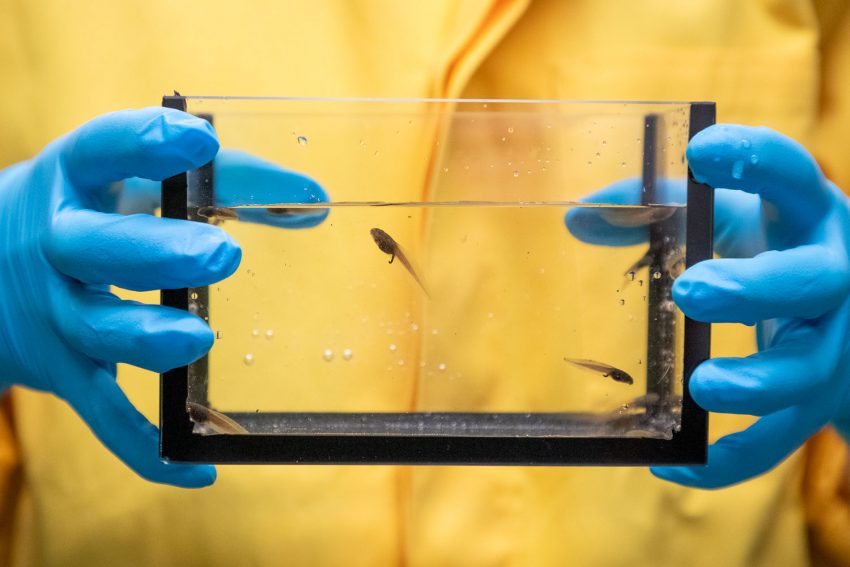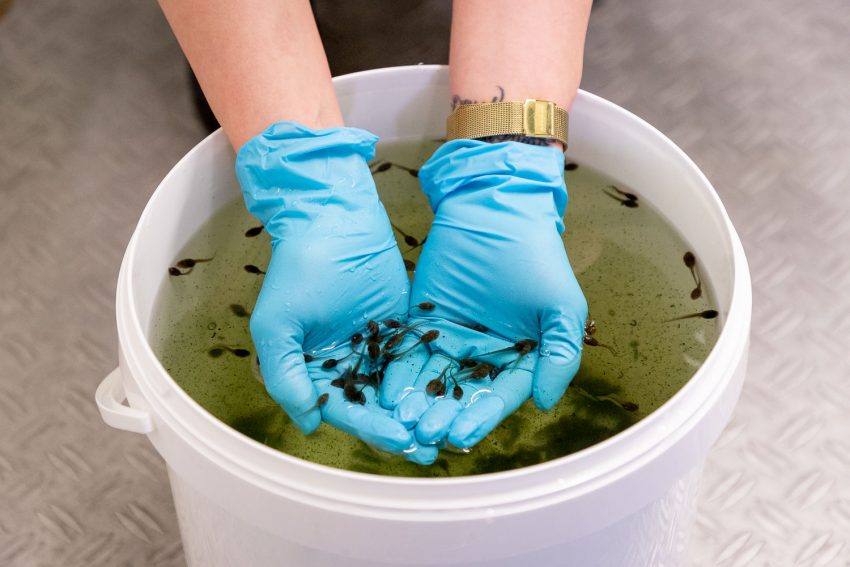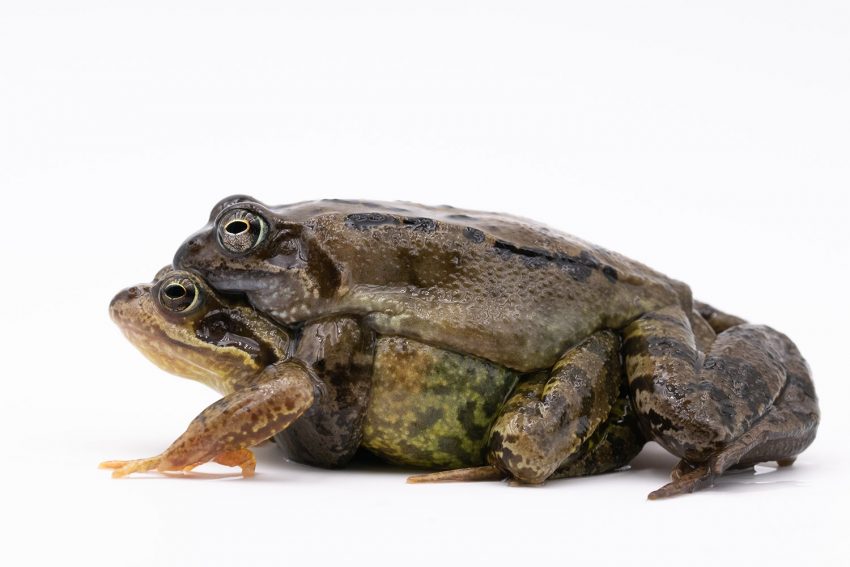More Stress, Fewer Frogs? Zoological Institute investigates environmental stress as a possible cause for creeping decline of grass frogs
In her project, funded by the German Research Foundation (DFG), biologist Dr. Katharina Ruthsatz at the Zoological Institute of the TU Braunschweig is investigating population declines in the grass frog. She is investigating to what extent the development of the grass frog is influenced by factors such as temperature fluctuations and nitrate pollution in the water.
The grass frog remains the most widespread native amphibian species, Dr. Katharina Ruthsatz said. However, drastic population declines have been noted in recent years, she said. Reasons for this could be disturbances related to anthropogenic global environmental changes such as habitat destruction, ongoing urbanization and expanding agriculture.

Dr. Katharina Ruthsatz in the “climate chamber” at the Zoological Institute. Picture credits: Markus Hörster/TU Braunschweig
Amphibians respond to environmental stressors
But Ruthsatz knows that even in habitats that are not affected by these direct disturbances, a population decline can be observed. Pollution, pathogens and climate change may be causing steady, gradual population declines. Amphibians would respond to such stressors with an increase in stress hormone levels, which would also affect development, morphology, physiology and immune function.
“A previous study was able to show that the stressor temperature in particular plays a significant role in the even distribution of available energy for development, growth and the transformation processes during metamorphosis,” Ruthsatz explains.
Early warning system signals stress
This is where Katharina Ruthsatz’s current research project comes in. The scientist wants to explain the role of these sublethal environmental stressors in the creeping population declines of the grass frog. In particular, Ruthsatz is investigating the short- and long-term effects of temperature fluctuations and nitrate pollution, which are judged to be extremely relevant in the spawning waters of the grass frog.
“In a previous work, we were able to show that water pollution with chemicals that affect metamorphosis in the grass frog reduces the acclimation potential of this species. In addition, these substances also negatively affect the energy budgets available for metamorphosis,” says Ruthsatz.
Two sub-tests
On the one hand, the new study is based on a field study that examines the effects of various nitrate loads in spawning waters on stress hormone levels in tadpoles and adult grass frogs. Second, a laboratory study is investigating the effects of various nitrate loads and temperature fluctuations on stress biomarkers during and after metamorphosis under controlled conditions.

At this stage of development, the tadpoles are only a few weeks old. Picture credits: Markus Hörster/TU Braunschweig
Field experiments in the “Kleiwiesen”
The “Kleiwiesen” near Braunschweig-Waggum is a spawning area of the grass frog with low nitrate contamination, as there is no agricultural use adjacent to it. It serves as a non-polluted control water in the research project. On site, stress hormone release is measured over three years in both tadpoles and adults. This is done non-invasively, i.e. without having to injure the animals, because amphibians release stress hormones into the water through their skin and urine.
For the study, female and male animals are placed in plastic containers with sterile, chlorine-free water each spring. “We do this at night directly at the spawning waters so as not to disturb the animals’ natural day-night rhythm,” emphasizes scientist Dr. Katharina Ruthsatz. After an hour, the animals would be released and the water immediately frozen at minus 18 degrees Celsius. Later, in the laboratory, the stress hormones could be filtered out and their concentration determined.
Laboratory experiments at the Zoological Institute
The first spawn balls were taken from the clover meadows in April 2021 and brought to a climate-controlled room at the Zoological Institute of the TU Braunschweig. After hatching, the tadpoles were distributed to a total of 54 aquaria. Nitrate is added to the water in a controlled manner. “We also distinguish tadpoles from parents that arrived earlier or later at the water body,” Ruthsatz said.

15 tadpoles live in each of the 54 aquariums. They have to be cleaned of algae on a regular basis. Picture credits: Markus Hörster/TU Braunschweig
The fact that climate change is causing it to warm up earlier and earlier in the course of the year, followed by another cold spell if necessary, could affect the phenology of the grass frogs, the periodically recurring growth and development phenomena. Another experimental group was able to hatch completely without nitrate pollution under laboratory conditions. The research is taking place at the Zoological Institute in the Evolutionary Biology Department led by Professor Miguel Vences.
“All surviving animals will be immediately released back into their home in the Waggum district of Braunschweig following the experiments,” explains Katharina Ruthsatz.
Better protection for native amphibians
The aim of the research project is to understand how the two stress factors of temperature fluctuations and nitrate pollution affect them in the short and long term. The results should form the basis for better protecting native amphibians such as the grass frog. The findings could be used for conservation strategies before populations of the animals dramatically decline throughout their range.

More tadpoles are in buckets. All surviving animals will be released immediately following the experiments. Picture credit: Markus Hörster/TU Braunschweig
Dr. Katharina Ruthsatz
The biologist has been leading an independent research group in the department of Professor Vences at the Zoological Institute of TU Braunschweig since July 2020. Initially, she studied biology and German at the University of Hamburg to become a teacher. When she was offered the opportunity to do a PhD after her master thesis, she took the chance and also did her PhD at the University of Hamburg on the topic “Amphibians in a changing world: an ecophysiological perspective on amphibian metamorphosis”. Her interest in amphibians has accompanied her since childhood.

